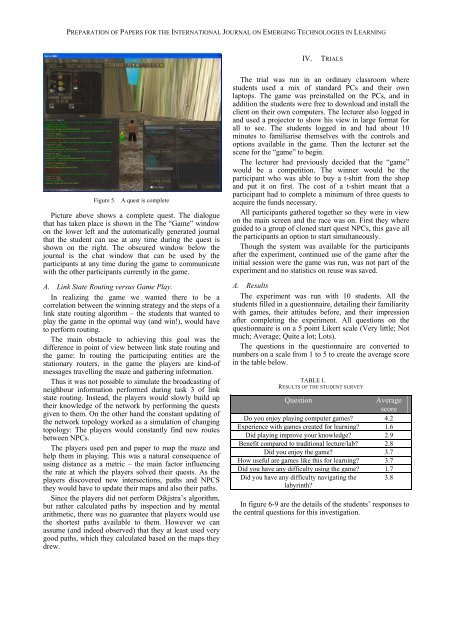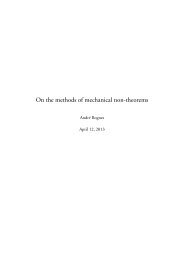A computer game modelling routing in computer networks as ...
A computer game modelling routing in computer networks as ...
A computer game modelling routing in computer networks as ...
Create successful ePaper yourself
Turn your PDF publications into a flip-book with our unique Google optimized e-Paper software.
PREPARATION OF PAPERS FOR THE INTERNATIONAL JOURNAL ON EMERGING TECHNOLOGIES IN LEARNING<br />
IV.<br />
TRIALS<br />
Figure 5. A quest is complete<br />
Picture above shows a complete quest. The dialogue<br />
that h<strong>as</strong> taken place is shown <strong>in</strong> the The “Game” w<strong>in</strong>dow<br />
on the lower left and the automatically generated journal<br />
that the student can use at any time dur<strong>in</strong>g the quest is<br />
shown on the right. The obscured w<strong>in</strong>dow below the<br />
journal is the chat w<strong>in</strong>dow that can be used by the<br />
participants at any time dur<strong>in</strong>g the <strong>game</strong> to communicate<br />
with the other participants currently <strong>in</strong> the <strong>game</strong>.<br />
A. L<strong>in</strong>k State Rout<strong>in</strong>g versus Game Play.<br />
In realiz<strong>in</strong>g the <strong>game</strong> we wanted there to be a<br />
correlation between the w<strong>in</strong>n<strong>in</strong>g strategy and the steps of a<br />
l<strong>in</strong>k state <strong>rout<strong>in</strong>g</strong> algorithm – the students that wanted to<br />
play the <strong>game</strong> <strong>in</strong> the optimal way (and w<strong>in</strong>!), would have<br />
to perform <strong>rout<strong>in</strong>g</strong>.<br />
The ma<strong>in</strong> obstacle to achiev<strong>in</strong>g this goal w<strong>as</strong> the<br />
difference <strong>in</strong> po<strong>in</strong>t of view between l<strong>in</strong>k state <strong>rout<strong>in</strong>g</strong> and<br />
the <strong>game</strong>: In <strong>rout<strong>in</strong>g</strong> the participat<strong>in</strong>g entities are the<br />
stationary routers, <strong>in</strong> the <strong>game</strong> the players are k<strong>in</strong>d-of<br />
messages travell<strong>in</strong>g the maze and gather<strong>in</strong>g <strong>in</strong>formation.<br />
Thus it w<strong>as</strong> not possible to simulate the broadc<strong>as</strong>t<strong>in</strong>g of<br />
neighbour <strong>in</strong>formation performed dur<strong>in</strong>g t<strong>as</strong>k 3 of l<strong>in</strong>k<br />
state <strong>rout<strong>in</strong>g</strong>. Instead, the players would slowly build up<br />
their knowledge of the network by perform<strong>in</strong>g the quests<br />
given to them. On the other hand the constant updat<strong>in</strong>g of<br />
the network topology worked <strong>as</strong> a simulation of chang<strong>in</strong>g<br />
topology: The players would constantly f<strong>in</strong>d new routes<br />
between NPCs.<br />
The players used pen and paper to map the maze and<br />
help them <strong>in</strong> play<strong>in</strong>g. This w<strong>as</strong> a natural consequence of<br />
us<strong>in</strong>g distance <strong>as</strong> a metric – the ma<strong>in</strong> factor <strong>in</strong>fluenc<strong>in</strong>g<br />
the rate at which the players solved their quests. As the<br />
players discovered new <strong>in</strong>tersections, paths and NPCS<br />
they would have to update their maps and also their paths.<br />
S<strong>in</strong>ce the players did not perform Dikjstra’s algorithm,<br />
but rather calculated paths by <strong>in</strong>spection and by mental<br />
arithmetic, there w<strong>as</strong> no guarantee that players would use<br />
the shortest paths available to them. However we can<br />
<strong>as</strong>sume (and <strong>in</strong>deed observed) that they at le<strong>as</strong>t used very<br />
good paths, which they calculated b<strong>as</strong>ed on the maps they<br />
drew.<br />
The trial w<strong>as</strong> run <strong>in</strong> an ord<strong>in</strong>ary cl<strong>as</strong>sroom where<br />
students used a mix of standard PCs and their own<br />
laptops. The <strong>game</strong> w<strong>as</strong> pre<strong>in</strong>stalled on the PCs, and <strong>in</strong><br />
addition the students were free to download and <strong>in</strong>stall the<br />
client on their own <strong>computer</strong>s. The lecturer also logged <strong>in</strong><br />
and used a projector to show his view <strong>in</strong> large format for<br />
all to see. The students logged <strong>in</strong> and had about 10<br />
m<strong>in</strong>utes to familiarise themselves with the controls and<br />
options available <strong>in</strong> the <strong>game</strong>. Then the lecturer set the<br />
scene for the “<strong>game</strong>” to beg<strong>in</strong>.<br />
The lecturer had previously decided that the “<strong>game</strong>”<br />
would be a competition. The w<strong>in</strong>ner would be the<br />
participant who w<strong>as</strong> able to buy a t-shirt from the shop<br />
and put it on first. The cost of a t-shirt meant that a<br />
participant had to complete a m<strong>in</strong>imum of three quests to<br />
acquire the funds necessary.<br />
All participants gathered together so they were <strong>in</strong> view<br />
on the ma<strong>in</strong> screen and the race w<strong>as</strong> on. First they where<br />
guided to a group of cloned start quest NPCs, this gave all<br />
the participants an option to start simultaneously.<br />
Though the system w<strong>as</strong> available for the participants<br />
after the experiment, cont<strong>in</strong>ued use of the <strong>game</strong> after the<br />
<strong>in</strong>itial session were the <strong>game</strong> w<strong>as</strong> run, w<strong>as</strong> not part of the<br />
experiment and no statistics on reuse w<strong>as</strong> saved.<br />
A. Results<br />
The experiment w<strong>as</strong> run with 10 students. All the<br />
students filled <strong>in</strong> a questionnaire, detail<strong>in</strong>g their familiarity<br />
with <strong>game</strong>s, their attitudes before, and their impression<br />
after complet<strong>in</strong>g the experiment. All questions on the<br />
questionnaire is on a 5 po<strong>in</strong>t Likert scale (Very little; Not<br />
much; Average; Quite a lot; Lots).<br />
The questions <strong>in</strong> the questionnaire are converted to<br />
numbers on a scale from 1 to 5 to create the average score<br />
<strong>in</strong> the table below.<br />
TABLE I.<br />
RESULTS OF THE STUDENT SURVEY<br />
Question<br />
Average<br />
score<br />
Do you enjoy play<strong>in</strong>g <strong>computer</strong> <strong>game</strong>s? 4.2<br />
Experience with <strong>game</strong>s created for learn<strong>in</strong>g? 1.6<br />
Did play<strong>in</strong>g improve your knowledge? 2.9<br />
Benefit compared to traditional lecture/lab? 2.8<br />
Did you enjoy the <strong>game</strong>? 3.7<br />
How useful are <strong>game</strong>s like this for learn<strong>in</strong>g? 3.7<br />
Did you have any difficulty us<strong>in</strong>g the <strong>game</strong>? 1.7<br />
Did you have any difficulty navigat<strong>in</strong>g the 3.8<br />
labyr<strong>in</strong>th?<br />
In figure 6-9 are the details of the students’ responses to<br />
the central questions for this <strong>in</strong>vestigation.
















